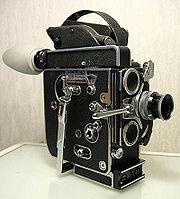
Bolex
Encyclopedia

Switzerland
Switzerland name of one of the Swiss cantons. ; ; ; or ), in its full name the Swiss Confederation , is a federal republic consisting of 26 cantons, with Bern as the seat of the federal authorities. The country is situated in Western Europe,Or Central Europe depending on the definition....
company (Bolex International S.A. of Yverdon) that manufactures motion picture cameras
Movie camera
The movie camera is a type of photographic camera which takes a rapid sequence of photographs on strips of film which was very popular for private use in the last century until its successor, the video camera, replaced it...
and lenses, the most notable products of which are in the 16 mm
16 mm film
16 mm film refers to a popular, economical gauge of film used for motion pictures and non-theatrical film making. 16 mm refers to the width of the film...
and Super 16 mm formats. The Bolex company was initially founded by Jacques Bogopolsky
Jacques Bogopolsky
Jacques Bogopolsky was a Ukrainian, , engineer and camera designer who was a prolific inventor of revolutionary movie cameras. The brand name Bolex comes from Jacques Bogopolsky. He was also instrumental in the initial design of the Alpa make of 35mm single-lens reflex cameras.- External links :**...
(a.k.a. Jacques Bolsey or Bolsky) in 1927. Bolex is derived from his name. He had previously designed cameras for Alpa
Alpa
Alpa was formerly a Swiss camera design company and manufacturer of 35 mm SLR cameras. The current owners bought the company name after bankruptcy of the original company and the company exists today as a designer and manufacturer of high-end medium-format cameras.-History:Alpa was an offshoot of...
. Bolex cameras were particularly important for early television news, nature films, documentaries and the avant garde, and are still favoured by many animators today. Whilst some later models are electrically powered, the majority of those manufactured since the 1930s use a spring-wound clockwork
Clockwork
A clockwork is the inner workings of either a mechanical clock or a device that operates in a similar fashion. Specifically, the term refers to a mechanical device utilizing a complex series of gears....
. The 16 mm spring-wound Bolex is a popular introductory camera in film school
Film school
The term film school is used to describe any educational institution dedicated to teaching aspects of filmmaking, including such subjects as film production, film theory, digital media production, and screenwriting. Film history courses and hands-on technical training are usually incorporated into...
s.
Today, the Bolex factory in Switzerland continues to produce new 16mm and Super 16 film cameras and also can convert Bolex H16 reflex models to super 16mm.
History
The Bolex company was initially founded by Jacques BogopolskyJacques Bogopolsky
Jacques Bogopolsky was a Ukrainian, , engineer and camera designer who was a prolific inventor of revolutionary movie cameras. The brand name Bolex comes from Jacques Bogopolsky. He was also instrumental in the initial design of the Alpa make of 35mm single-lens reflex cameras.- External links :**...
(a.k.a. Jacques Bolsey or Bolsky) in 1927 under the name of Bol. Bolex is derived from his name. He had previously designed cameras for Alpa
Alpa
Alpa was formerly a Swiss camera design company and manufacturer of 35 mm SLR cameras. The current owners bought the company name after bankruptcy of the original company and the company exists today as a designer and manufacturer of high-end medium-format cameras.-History:Alpa was an offshoot of...
. In 1930 Jacques sold the company to the Paillard Company who retained his services until the mid 1930s. The 1935 H-16 camera is a development of the Auto Cine B model. 9.5mm and 8mm versions followed. The H-16 was highly successful and Paillard Bolex introduced the L-8 for the market for a smaller 8mm camera. With the post-war boom in home movie making, Paillard Bolex continued to develop its 8mm and 16mm ranges with the H-16 increasingly adopted by professional film makers. The company also made a successful range of high end movie projectors for all the film making gauges.
In 1965 Kodak introduced the Super 8mm format. Paillard Bolex were slow to introduce a Super 8 camera although they quickly modified the 18-5 Auto 8mm projector for Super 8 as the 18-5 Super. At about this time the 16 Pro Camera was introduced as a technically advanced professional camera more suited to television use than the H-16.
In 1970 Paillard sold the Bolex division to Eumig of Vienna. Eumig rationalised the Super 8 range and no more Super 8 cameras or projectors were produced in Switzerland. Bolex 8mm products were henceforth made in Austria while the 16mm cameras continued unaffected.
In 1981 Eumig went into liquidation and Bolex was bought by a management team who set up Bolex International in 1982. Today, the Bolex factory in Switzerland continues to produce new 16mm and Super 16 film cameras and also can convert Bolex H16 reflex models to super 16mm.
Bolex Cameras, Selected List
- Auto Cine A (1928)
- Auto Cine B (1929)
- H-16 (1935)
- H-9 (1935)
- H-8 (1938)
- L-8 (1942)
- B-8 (1953)
- C-8 (1954)
- H-16 Reflex (1956)
- D-8L (1959)
- P1 (1961)
- K1 (1963)
- H-16 Rx-5 (1966)
- 150 Super (1967)
- 16 Pro (1968)
- 7.5 Macrozoom (1969)
- H-16 SB and SBM (1970)
- H-16 EBM (1971)
- H-16 EL (1975)
External links
- Bolex company website
- Documentary on the inventor of the Bolex
- Bolex Operating Manuals
- Bolex Manuals and Catalogs
- A history of Bolex cameras with serial numbers & years of manufacture
- Bolex Collector 8mm and 16mm Bolex cameras and projectors

